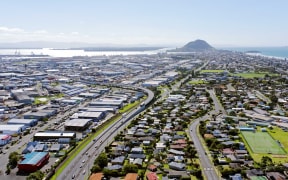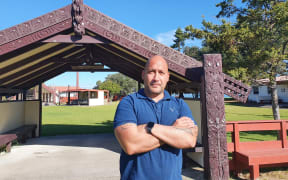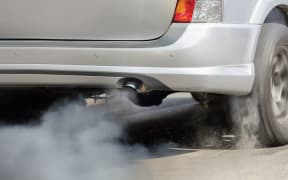![The review confirmed poor air quality at Mount Maunganui was creating significant health risks and premature deaths. Photo: Supplied. [via LDR Single use only]](https://media.rnztools.nz/rnz/image/upload/s--W6pGjjH2--/ar_16:10,c_fill,f_auto,g_auto,q_auto,w_1050/v1714508926/4KQVDS3_Mt_Industrial_LDR_scaled_jpg)
The review confirmed poor air quality at Mount Maunganui was creating significant health risks and premature deaths. Photo: Supplied via LDR
Mount Maunganui's poor air quality has been confirmed as impacting people's health, forcing officials to weigh up the future of the city's industrial sites.
Commission chairperson Anne Tolley said there was a "critical need" to find alternate sites for businesses that emit pollutants in the Mount Maunganui industrial area.
At a Tauranga City Council meeting on Monday, the commission was presented with the findings of the council-initiated review of the Air Pollution: Health Risk Assessment Mount Maunganui report.
The review is of the earlier report, released in July 2023, that showed poor air quality at Mount Maunganui was creating significant health risks and causing premature deaths.
The report found modelling for PM10 contributed to an estimated 13 premature deaths in Mount Maunganui each year. PM10 are particles in the air that have a diameter of 10 microns or less and can be harmful when inhaled.
The findings of that study, published by Toi Te Ora Public Health Organisation and Te Whatu Ora - Health NZ, estimated the social cost of the premature deaths and ailments was $22 million.
Tauranga's council and the Bay of Plenty Regional Council confirmed those findings in their own review. The review was sought as councils needed to rely on the health risk findings for future decision making.
![Commission chair Anne Tolley said there was a "critical need” to find space for emitting businesses. Bay of Plenty Times Photo / Alex Cairns [via LDR Single use only]](https://media.rnztools.nz/rnz/image/upload/s--WPY8SRtk--/ar_16:10,c_fill,f_auto,g_auto,q_auto,w_1050/v1714508940/4KQVDRO_Anne_Tolley_acBOPT_1_scaled_jpg)
Commission chairperson Anne Tolley said there was a "critical need" to find space for emitting businesses. Photo: Bay of Plenty Times / Alex Cairns
Tolley said the council had dealt with issues raised in the report and review as much as it was legally able to through the spatial plan, she said.
A spatial plan set the direction of how an area should be developed in future.
Tolley said she raised the importance of "the critical need" to find space for emitting businesses in the sub-regional spatial plan and Smartgrowth spatial plan.
"In particular our roading material manufacturers, because we don't want to lose them out of the area.
"We run the risk of them having really quite restrictive conditions put on them in that port industrial area and picking up and moving. And that just puts all the cost of our roading up dramatically.
"Even to the extent of trying to find somewhere for them to eventually move to that is less restrictive for them, but enables them to remain within the area," Tolley said.
An airshed was introduced over the Mount Maunganui industrial area in 2019 to enable tighter rules and resource consent decisions and a greater ability to manage industrial discharges.
Council urban communities team leader Carl Lucca's report to council said the Toi Te Ora study supported the need to manage and minimise emissions of all contaminants in the Mount Maunganui Airshed, but with specific attention to fine particulate matter (PM10, PM2.5), nitrogen dioxide and sulphur dioxide.
The main sources of PM10, PM2.5 and sulphur dioxide were industrial activities, port activities and shipping. Motor vehicles and shipping were the main sources of nitrogen dioxide.
![Whareroa Marae is in the Mount Maunganui industrial area. Photo: John Borren/SunLive. [via LDR Single use only]](https://media.rnztools.nz/rnz/image/upload/s--xrp3De2M--/ar_16:10,c_fill,f_auto,g_auto,q_auto,w_1050/v1714508927/4KQVDS3_Whareroa_Marae_scaled_jpg)
Whareroa Marae is in the Mount Maunganui industrial area. Photo: John Borren / SunLive
Resource consents and land use planning were tools that could be used to improve air quality from industrial and trade activities and land use planning could assist by minimising exposures, Lucca's report said.
Tolley asked if the council had identified all the appropriate issues.
Lucca said between the regional council and city council they were "acutely aware" of the issues, and there were action plans to address the existing issues.
This included spatial plans, the regional council's air quality management plan and additional air quality monitoring, Lucca said.
The council was working on Proposed Plan Change 38 that included options to address land use conflicts between existing industrial activity and residential areas, including Whareroa marae within the Mount Maunganui Airshed.
Whareroa Marae environment spokesperson Joel Ngātuere previously told Local Democracy Reporting the marae's people were "being poisoned" from the pollution.
"We are directly impacted because they're [heavy industry] right on our doorstep. But we're not the only ones in the Mount to raise concerns around our respiratory issues."
The city council can only effect change for future users of the land. It cannot change existing land uses that have use rights under the Resource Management Act 1991.
LDR is local body journalism co-funded by RNZ and NZ On Air





